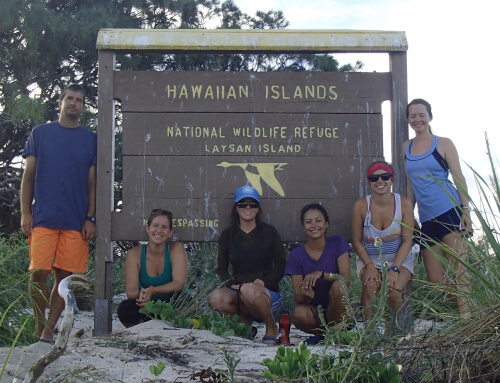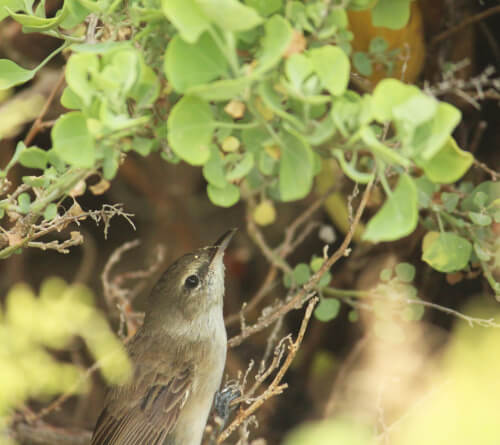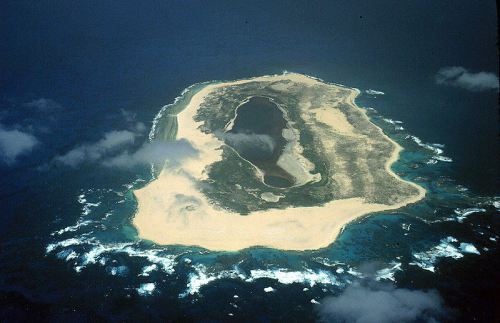There and Back Again: To Laysan with Love

The Laysan 2014 crew from left to right: Robby Kohley (ABC), Barbara Heindl (ABC), Whitney Taylor (NOAA), Megan Dalton (ABC), Hope Ronco (NOAA), and Genni Brookshire (NOAA). Photo by Hope Ronco
October 30, 2014 | By Megan Dalton
It's a little surreal. September on Laysan just flew by, then we all left the island, and now I'm sitting at my desk at home in Salt Lake City, tapping away at the computer, not needing to swat at the previously omnipresent flies buzzing about my person. I'm not even sweating profusely, simply sitting in a chair – in fact, I've got a space heater at my feet and a fleece jacket on. But unforgiving flies and heat notwithstanding, I miss Laysan a lot.
I treasure my Laysan experiences. There is nothing quite like waking up in a place so vibrant, so noisy, and bustling heartily with wildlife, where every square foot of land (and sometimes air) is occupied by some sort of seabird, plant, duck, seal, crab, songbird… some of them endemic species found nowhere else in the world!
There is nothing quite like commuting to and from work among such unique traffic, and under the latest lovely sunrise or dark and foreboding storm cloud. And nothing like being a spectator with a front-row seat to the seasonal rhythms and progressions of such a place.
[wpvideo o8fafg9k]Typical scene during sunset on Laysan, taken in April 2013. Birds seen and heard in this clip include Laysan Albatrosses, Black-footed Albatrosses, Sooty Terns, White Terns, Great Frigatebirds, Red-footed Boobies, Masked Boobies, and Bonin Petrels. Video by Megan Dalton
Laysan is one of those rare places that takes you back to a time when things were untamed and unbridled by our increasingly large human footprint, a feeling made all the more compelling by the island's twentieth century to-the-brink-and-back story. I'm incredibly grateful to have spent time there.
Last-minute Developments
I'm certain, though, that Laysan and its inhabitants don't even notice that everyone has left, and they are getting along just fine since our departure. During our last week on island, we had a couple of neat developments. The first was that, along with 10 USFWS staff and volunteers, we helped to remove all living Indian fleabane (Pluchea indica – a long-standing, dense, invasive shrub) from Laysan. Although we removed all the standing plants, there is an extensive seed bank that USFWS Refuge staff will be back to deal with in 2015. This is still exciting because the removal will give the native vegetation a chance to recolonize those areas that Pluchea used to so thoroughly dominate.
The second development was particularly exciting for the Millerbird team: during our very last island-wide survey, we found several Millerbirds in areas outside of NIMI Land for the first time!

One of my favorite pictures I took on Laysan: this Millerbird female, an original translocatee from Nihoa in 2012, is part of one of the most prolific breeding pairs on Laysan to date (with eight known successful fledglings). Here she is at the NW Bowl territory, brooding one of her growing chicks. Photo by Megan Dalton
All Millerbirds since the original 2011 and 2012 translocations to Laysan have remained in NIMI Land, or the northern part of the island that is dominated by native beach naupaka (Scaevola taccada), with the exception of a few adventurous birds in 2011 that went to the far south of the island.
Island-wide surveys have been conducted regularly to detect any movement outside of this area, but no birds were ever found in places outside the popular NIMI Land. That is until two days before our departure when, while performing our last island-wide survey, we observed one Millerbird breeding pair and at least three non-territorial individuals in a habitat comprised mostly of a different native shrub, ‘āweoweo (Chenopodium oahuense)!

Unusual sighting on Laysan: a Millerbird perched – not in naupaka – but in an ‘āweoweo shrub. Photo by Megan Dalton
A Sign of Good Things to Come
Millerbirds in ‘āweoweo is significant for a couple of reasons. First, it exemplifies the incredible amount of progress the native vegetation has shown in recent years. The Hawaiian Islands National Wildlife Refuge staff and volunteers have worked hard to help re-establish plants that disappeared after the island was denuded by rabbits a century ago, and nearly all of the ‘āweoweo present are a result of those efforts.
The second reason to be excited is that if Millerbirds are using new species such as ‘āweoweo or bunchgrass (Eragrostis variabilis), the potential for population growth on Laysan is much higher than if they remain limited to the naupaka. There is a lot of potentially suitable habitat remaining outside of NIMI Land that the Millerbirds haven't occupied yet, and we are just waiting to see to if they decide to claim it. Seeing a few Millerbirds using ‘āweoweo is a good indication that they will! As we end the intensive study of the Millerbirds and transition to monitoring them like the other endangered bird species on Laysan, this is a very optimistic note for our departure.

Aerial view of Laysan taken from the north showing the extent of beach naupaka and morning glory (dark green areas), as well as bunchgrass (dappled, lighter green area). ‘Āweoweo is not prevalent enough to be seen here. The Millerbird population is currently residing in the naupaka north of the lake. We hope that in the future, Millerbirds will expand to other parts of the island. Photo by Robert J. Shallenberger, USFWS
Meanwhile, I'll be here at home in my wool socks and beanie wistfully looking at our Laysan adventure pictures, wishing the Millerbirds and all their neighbors well. Laysan, thanks for having us!
 Megan Dalton is from Salt Lake City, Utah, and has worked as an avian field biologist for several years on both the mainland and in Hawai‘i. She just returned from Laysan where she recently achieved her life goals of being a momentary perch for a curious Laysan Duck and tricking both of her crew mates with her Millerbird song impression.
Megan Dalton is from Salt Lake City, Utah, and has worked as an avian field biologist for several years on both the mainland and in Hawai‘i. She just returned from Laysan where she recently achieved her life goals of being a momentary perch for a curious Laysan Duck and tricking both of her crew mates with her Millerbird song impression.


















































